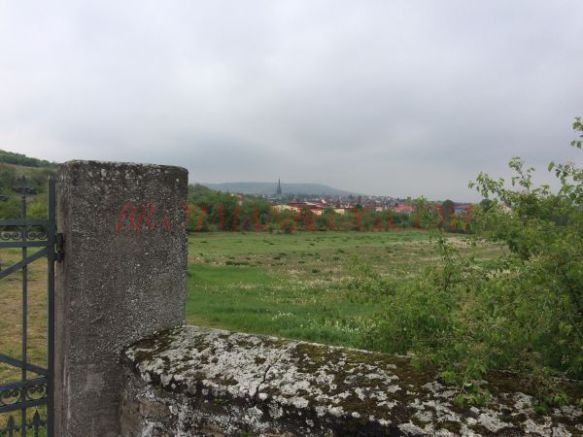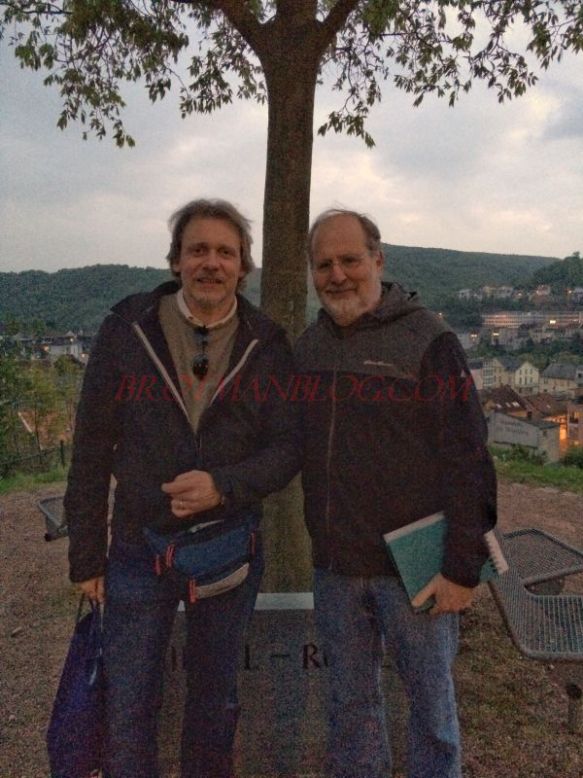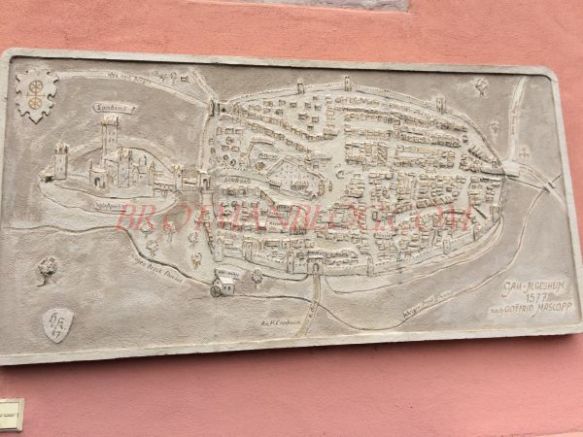On our second night in Germany (May 3), we had a truly joyful and unforgettable experience: dinner with Wolfgang and his family—his wife Bärbel and their twelve year old daughter Milena. We met in the small town of Schwabenheim, located about halfway between Bingen, where we were staying, and Undenheim, where Wolfgang and his family live. I could not remember the name of the restaurant, but fortunately I was able to WhatsApp with Milena who told me it was zum Engel. The atmosphere was perfect—an old stone building divided into smaller rooms with just a few tables. It was a good thing that for much of the time we had our room to ourselves because there was much laughter throughout our meal.
All three Seligmanns understand English, but I wanted to practice my German. So we switched back and forth, often with many questions about which word to use (on my part) and some inevitable misunderstandings based on use of the incorrect word (again, on my part). It could not have been a more enjoyable and relaxing evening—remarkable given that I’d never met Milena or Bärbel before and had only met Wolfgang the day before. The food was also excellent—salmon, potatoes, and my first experience with the white asparagus that is so popular in Germany—“spargel.” Es war lecker, as they say. When Wolfgang asked at the end of the evening whether we wanted to have dinner with them all the next night, there was no hesitation. “Of course,” we said. (I think the German equivalent expression is “genau”—a word we heard over and over when we listed to Germans converse with each other.)
The following day Wolfgang, Harvey, and I traveled to Gau-Algesheim, the birthplace of my great-great-grandfather, Bernard Seligman, and of his younger brother August Seligmann, Wolfgang’s great-grandfather. But first Wolfgang took us to see the Rochus Chapel outside of Bingen where his grandparents and father and uncle hid during the bombing of Bingen during World War II. It is lovely church perched high above Bingen surrounded by trees and views of the valley and of the Rhine. It was easy to see how this must have been a peaceful sanctuary for Wolfgang’s family and others during the bombing.
In some ways the survival of Wolfgang’s grandfather, father, and uncle is a miracle. Julius Seligmann was born Jewish, but converted when he married Magdalena Kleisinger, who was Catholic. Their sons, Walter and Herbert, were raised as Catholics. But in Nazi doctrine, that should not have mattered. Julius had “Jewish blood,” and so did his sons. Many of those with Jewish ancestors who converted or who were raised as Christians were not spared from death by the Nazis.
When I asked Wolfgang why he thought his grandfather, father, and uncle survived, he said that his mother always said that the Bingen Nazis were stupid. Or that perhaps the police in Bingen somehow provided protection. As I wrote earlier, Wolfgang’s father Walter did forced labor on the Siegfried Line during the war and there were restrictions placed on the men in terms of their occupations, but they were not deported or tortured. I am thankful for that; otherwise, my dear cousins Wolfgang, Bärbel, and Milena would not be part of my life.
After leaving Rochus Chapel, we drove the short distance to Gau-Algesheim where we were to meet Dorothee Lottmann-Kaeseler, another German dedicated to preserving and honoring the history of the Jews in Germany. Dorothee and I had connected several years back through JewishGen.org when I was searching for information about Gau-Algesheim. She had worked on a cemetery restoration project with Walter Nathan, a man whose father’s roots were in Gau-Algesheim; Walter and his family had escaped to the US in 1936. Dorothee and I have been exchanging information through email for several years—going far beyond my initial inquiries about Gau-Algesheim, and she is a regular reader and frequent commenter on my blog. I was very much looking forward to meeting this friend in person, and she is terrific—outgoing, energetic, interesting, smart, and very insightful.
But it took some chasing to catch her! We drove up the road below the cemetery, and Wolfgang spotted what he believed was her car up on the hill near the cemetery gate. We got out of the car and clambered up the hill only to see that Dorothee’s car had disappeared. (We were a few minutes late arriving.) So we ran back down the hill, got in Wolfgang’s car, and raced back down the road where we again spotted Dorothee’s car. She had driven back down, thinking we might have missed her. It was like a scene out of a bad romantic comedy!
Anyway, after introductions were made and hugs exchanged, we all drove back up to the cemetery gate. Dorothee was accompanied by a Gau-Algesheim resident named Manfred Wantzen, who had the key to the cemetery. But before we entered, Dorothee reminded us that in fact there were very few stones in the cemetery. This was not an act of Nazi destruction; this was an act of stupidity on the part of a man in the 1983 who may have had good intentions. He thought the cemetery needed to be cleaned up and asked permission of the Jewish community in Mainz (which oversees the cemetery). They agreed without asking what he planned to do. The man then proceeded to remove the stones so he could cut the grass. Some he placed against the cemetery wall, but others were carted away and lost forever.
When Dorothee and Walter Nathan worked to preserve what was left of the cemetery, several plaques and markers were placed on the wall outside and inside the cemetery, one to commemorate those who were killed in the Holocaust and others to honor the memory of those who were buried in the cemetery but whose stones were no longer there.
Unfortunately, there were no stones to be found for my 3-x great-grandparents, Moritz Seligmann and Babetta Schoenfeld, who were undoubtedly buried in that cemetery. There were likely many other relatives buried there, including Wolfgang’s great-grandfather August Seligmann, but the only family member whose stone survived is that of Rosa Bergmann Seligmann, August’s wife and Wolfgang’s great-grandmother. But even that discovery was bittersweet as her stone had been vandalized several years ago by some local teenagers. Wolfgang and I each placed a stone on her grave to mark that we had been there and to honor her and all the other Seligmanns buried there.
Although I left the cemetery disappointed and somewhat disheartened, my spirits were lifted when we drove into Gau-Algesheim and I got to see this little town of 7000 people where my ancestors had once lived. I have written before about Gau-Algesheim and seen photographs, but it was an entirely different experience being there in person and imagining a young Bernard Seligmann running through the narrow streets into the main square of the town where Langstrasse and Flosserstrasse meet and where the town hall and the fountain are located. Here is Wolfgang standing where perhaps our mutual ancestors Moritz and Babetta once stood with their children:
Dorothee had arranged for us to meet with the mayor of Gau-Algesheim, Dieter Faust. We sat in his office where everyone but Harvey and I spoke rapid German. I tried to understand, but it was futile. The mayor was extremely engaging and clearly excited to have two descendants of Gau-Algesheim residents visiting, and after signing his guest book and taking photographs, we all went to lunch—in an Italian restaurant in the middle of this small German town. And it was excellent! Somehow we all managed to converse and even managed to discuss American, French, and German politics with Dorothee and Wolfgang acting as interpreters. It was a delightful experience.

Burgermeister Dieter Faust, Dorothee Lottman-Kaeseler, Wolfgang Seligmann, Manfred Wantzen, me, and Harvey
After lunch, Herr Wantzen and Dorothee guided us through the small town where we saw what had once been the synagogue in Gau-Algesheim. It closed before 1932 because there was no longer a Jewish community in Gau-Algesheim. Today it is a storage shed behind someone’s house. But the stained glass window over the door and the windows convey that this was once a house of prayer. A shul where my ancestors prayed almost 200 years ago. It was awful to see its current condition, and I wish there was some way to create a fund to protect and restore the building before it deteriorates any further. I am hoping I can figure that out.
We walked then along the streets where my family had once lived, saw the building where Wolfgang’s grandfather Julius once had a shop, and the street where my great-great-grandfather Bernard and his siblings were born. It was surreal. And emotionally exhausting.
Our last stop was the Catholic Church in Gau-Algesheim, which Herr Wantzen was very excited to show us. It was beautiful—far larger and more elaborate than one might expect in such a small town. And a striking contrast to the size and condition of the abandoned synagogue.
We said goodbye to Dorothee and Herr Wantzen and returned to our hotel for a rest, and then at 6, Wolfgang picked up us again for dinner with his family in Bingen. We went to another very good restaurant, Alten Wache, and again had a wonderful time.
After dinner we all climbed up the many steps to the Burg Klopp, the medieval castle that sits at the top of the hill overlooking Bingen. As the sun began to set, the views were awe-inspiring. But I was already starting to feel emotional about saying goodbye to my wonderful cousins, Wolfgang, Bärbel, and Milena. When Milena said to me in her perfect English that she was going to miss me, my eyes filled with tears.
It was very hard to say goodbye, but I know that I will see my Seligmann cousins again—somewhere, sometime. And until then, we have WhatsApp, email, and all our wonderful memories. Auf wiedersehen, Wolfgang, Bärbel, Milena—and Bingen, Gau-Algesheim, and Mainz. It was time to move on the next step of our journey.















































It is amazing that the family survived!
LikeLiked by 1 person
I know….
LikeLiked by 1 person
I’m enjoying your visit to Germany….
LikeLiked by 2 people
Thanks—I am enjoying reliving it!
LikeLiked by 1 person
The pictures are wonderful
LikeLiked by 2 people
Thank you!
LikeLike
A superb account of your journey so far. I know how it is with the emotional exhaustion but you
have such wonderful memories. I love the group photo too. All ages represented.
LikeLiked by 1 person
Thanks, Shirley!
LikeLike
It’s a good thing the Nazi’s were stupid, eh? Looks like a happy family and grand surroundings. How terrific you made the trip!
LikeLiked by 1 person
Thank you!! Me, too!
LikeLiked by 1 person
Everything is so beautiful. I love the in-person connections you made with so many people you had corresponded with for so long, especially Wolfgang, Bärbel, and Milena. I’m sad too and I didn’t even meet them. 😉
LikeLiked by 2 people
I do miss them all. It was so amazing to be with them.
LikeLiked by 1 person
Thanks, Luanne. It really was special. And I can’t believe you also have family from that area!
LikeLike
I’m so happy for you. ❤
LikeLiked by 1 person
What a fabulously amazing and wonderful (and other glowing adjectives!) post! I love that the family survived, first of all, and then for you to meet your cousins and to experience the area through their eyes as well as your own is so precious. And what wonderful town photos! And then special for me additionally is that this is so close to where my dad’s family came from–Budesheim, just outside of Bingen.
LikeLike
Seems my reply went to the wrong place. That’s what happens when I try to respond on my phone. Anyway, Thank you!! I bet we were very close to Budenheim. I could have taken some photos.
LikeLiked by 1 person
Oh, that would have been cool!
LikeLiked by 1 person
Love the photos. And yes, doesn’t it fill you with so many emotions at once to actually walk the same streets your ancestors once did? I felt that way, too, when we went to Agropoli.
LikeLiked by 1 person
Yes, a flood of emotions.
LikeLiked by 1 person
Walter Nathan in 1936 went to the cemetery with his “Bar Mizva” camera and took photos of the family gravestones. Post 1945 several photos of individual gravestones or small groups were taken which show that quite a few stones were still there. And I found in an archive 2 pictures: overview from the lower end, taken 1971, also shown on the second poster – of three posters which I demanded – now at the wall next to the entry.

My colleague and friend Joachim Hahn is responsible for the amazing online presentation of Jewish history (synagogues and cemeteries) in many parts of Germany.
This can be very helpful to get an overview from abroad!! And of course he was one of the first persons to receive this award: http://obermayer.us/award/awardees/hahn-eng.htm
LikeLiked by 1 person
Thank you, Dorothee, for the additional information. As always, your insights and thoughts are very much appreciated.
LikeLike
I am in awe of your visit and the connections you made. The town of Gau-Algesheim looks delightful – so glad you were able to spend time there and had so many people to show you around. I’m anxious to read about your next stop.
LikeLiked by 1 person
Thanks, Debi—it was really one of the best days of our trip. The people and the place made it very special.
LikeLike
What a visit! What a story! So fortunate that your relatives survived. You take gorgeous photos.
LikeLiked by 1 person
Thank you! It was an amazing visit.
LikeLike
Per chance I came back to this entry, have just been communication with Mr. Wantzen who was so helpful. My old friend Walter Nathan with family roots here – which led to the “monument” on the cemetery passed, age 95…But I am in touch with family members and will send them this link.
All the best, Dorothee
LikeLiked by 1 person
I’m so sorry to hear that about Walter. He was an inspiration to me. Thanks for letting me know, Dorothee.
LikeLike
Hi Amy,
I’m Walter Nathan’s nephew, the son of his eldest brother, Franz, and I had the pleasure of attending the rededication of the Gau Algesheim Jewish Cemetery on Nov. 9, 2008. I stumbled on your blog while doing an online search for information about the current condition of the cemetery. I hope to return there next year. So thanks for the account of your visit and the many photos. By the way, I’m sure we are somehow related. There are several Seligmanns in the Nathan family tree.
Fond regards,
James Nathan
LikeLiked by 1 person
Hi James! I am delighted to hear from you. I am about to hit the road for several days, but will try and email you directly when I have a chance.
LikeLike